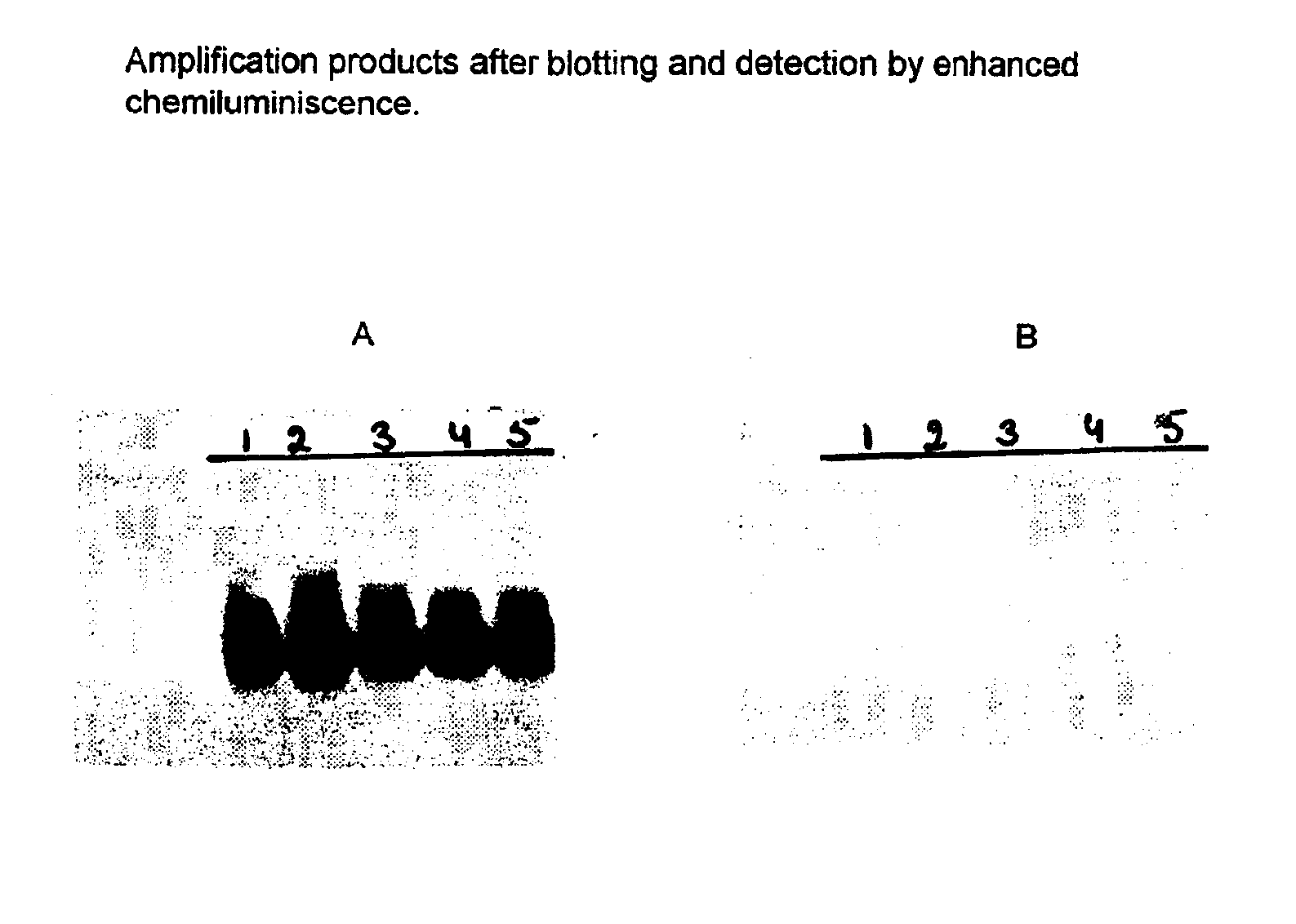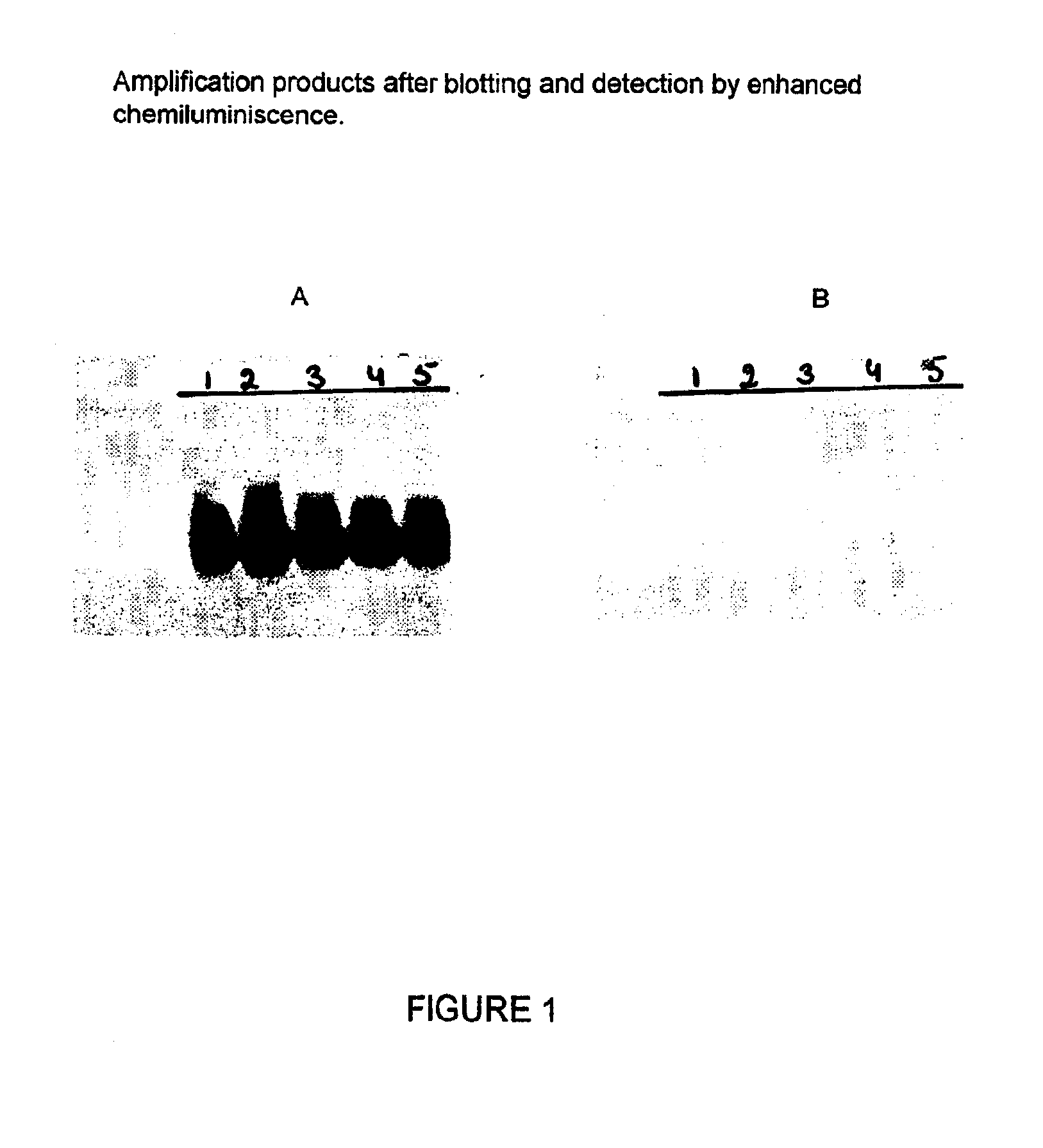Nucleic acid sequences that can be used as primers and probes in the amplification and detection of all subtypes of HIV-1
a technology probes, applied in the field of nucleic acid sequences, can solve the problems of not developing primer pairs or hybridization probes that would allow, and achieve the effect of high accuracy and sensitivity
- Summary
- Abstract
- Description
- Claims
- Application Information
AI Technical Summary
Benefits of technology
Problems solved by technology
Method used
Image
Examples
example 1
Amplification and Detection of HIV-1 Genomic RNA
[0067]The following procedures were applied to amplify and detect HIV-1 genomic RNA from samples as described in the following examples.
Sample preparation and nucleic acid isolation.
[0068]The isolation of the nucleic acids was performed according to Boom et al., 1990, Journal of Clinical Microbiology 28, 495-503 and European patent no. EP0389063. In short: A volume of 200 μl of pooled plasma's from healthy donors (negative for HBsAg, anti-HIV and anti-HCV) was added to 900 μl of lysis buffer (47 mM Tris-HCl pH 7.2, 20 mM EDTA, 12% Trition X-100, 4.7 M guanidine thiocyanate (GuSCN, Fluka, Buchs, Switzerland)). After vortexing and centrifugation (30 seconds, 13,000 rpm) a dilution series of HIV-1 RNA subtype B standard, characterised and described by Layne et al., 1992, Virology 189, 695-714 or HIV-1 positive specimens, was added. Upon addition of 50 μl activated silicon (0.4 g / ml suspension in 0.1 N HCl), the suspension was incubated fo...
example 2
Amplification and Detection of HIV-1 Genomic RNA
[0091]The following primer pairs were tested on 104 copies (as determined by spectrophotometry at 260 nm) of the HIV-1 RNA standard. The RNA was added directly into the amplification. The analysis of the amplified products was performed by gel electophoresis as described in example 1. The results are shown in the FIG. 1.
[0092]All primer pairs and probes of the present invention were able to amplify and detect HIV-1 RNA from subtype B to a similar extent. Analytical sensitivity is shown for two primer pairs (SEQ ID 9 / SEQ ID 5 and SEQ ID11 / SEQ ID 5) using a dilution series of the HIV-1 RNA standard which has an initial concentration of 5.5*109 copies / ml. The detection was done with probes having the sequences as depicted in SEQ ID 7 and SEQ ID 6. The amplification and detection was carried out as described in example 1. Table 1 shows the results obtained with both primer pairs.
[0093]
TABLE 1HIV-1 RNASEQ ID 3-SEQ ID 5SEQ ID 9-SEQ ID 5copie...
example 3
Amplification and Detection of HIV-1 RNA in Presence of an Internal Control
[0095]In this example the primer pair SEQ ID 9 / SEQ ID 5 and probe with the sequence of SEQ ID 7 was tested on dilution series of the HIV-1 RNA standard in presence of an internal control (ic-) RNA. The ic-RNA is an in vitro transcript which contains part of the LTR sequence of HIV-1 HXB-2 and 104 copies (as determined by spectrophotometry at 260 nm) are added prior to nucleic acids isolation. The isolation, amplification and ECL detection was performed as described in example 1. As a comparison, separate amplification and detection was performed using a primer pair located in the HIV-1 gag region (P1 / P2) previously described by Van Gemen et al, 1993, Journal of Virological Methods 43, 177-188. The probes used to detect the amplification products generated by the gag based primer pair were:[0096]Biotin probe: 5′-TGTTAAAAGAGACCATCAATGAGGA.[0097]ECL probe: 5′-GAATGGGATAGAGTGCATCCAGTG.
[0098]Results are shown in T...
PUM
| Property | Measurement | Unit |
|---|---|---|
| volume | aaaaa | aaaaa |
| volume | aaaaa | aaaaa |
| pH | aaaaa | aaaaa |
Abstract
Description
Claims
Application Information
 Login to View More
Login to View More - R&D
- Intellectual Property
- Life Sciences
- Materials
- Tech Scout
- Unparalleled Data Quality
- Higher Quality Content
- 60% Fewer Hallucinations
Browse by: Latest US Patents, China's latest patents, Technical Efficacy Thesaurus, Application Domain, Technology Topic, Popular Technical Reports.
© 2025 PatSnap. All rights reserved.Legal|Privacy policy|Modern Slavery Act Transparency Statement|Sitemap|About US| Contact US: help@patsnap.com


